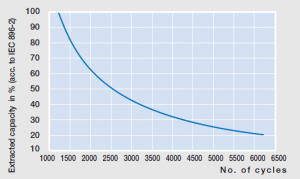Battery Storage – Case Study of Grid Connected Solar PV System
Scenario
This is a case study of a solar PV installation completed in 2015 for a customer enquiring about the use of battery storage to save on electrical infrastructure costs. There are generally 5 use cases for battery storage in Australia. This is a case of grid augmentation.
The customer has grid supplied electrical power to his home. However he has built an extension to it which he now wishes to electrify. His original house is quite an old building with outdated electrical infrastructure. His local electricity distributor has informed him that in order to power the new extension, he would need to upgrade the existing switchboard as well as the electricity line supplying it from the distribution network. This would involve laying underground cables from the network point of supply to his house. The distributor provided an estimate of the total cost for the upgrades at $25,000. This is infrastructure that would be installed, owned and operated by the distributor. The customer decided to explore the use of solar power with battery storage to provide the additional power capacity for his home.
Electricity Usage
At the time of the installation, the customer is on a time of use tariff with a peak period occurring Monday-Friday, 7am-11pm. The peak tariff is 31.6 cents/kWh excluding GST with the off-peak at 14.1 cents/kWh. An analysis of the electricity meter data shows that the average daily usage is approximately 16kWh/day. Although there is no data on what the additional usage will be from the extension, an estimation of 21kWh/day is made based on a site visit and a discussion with the customer about the purpose of the extension and the appliances to be fitted therein. The load profile is scaled up to match the new daily total usage.
Solar System Design
Overall Configuration and Features
An industry standard software known as PVsyst is utilised to determine the annual power generation of a solar system, based on its rated capacity, orientation and geographic location. Utilising PVsyst in conjunction with the customer’s load profile and giving consideration to future power requirements, it is determined that a PV array of 7.5kW rated capacity would be adequate to service the customer’s needs.
The design philosophy for the hybrid solar system is to maximise self-consumption of all solar energy produced and to use the grid as a back-up in the case of insufficient power generation. The PV array is AC coupled with a solar inverter which is connected to a battery inverter-charger that powers the battery bank. The inverter-charger is also able to charge the battery bank from the grid in case there is a period of successive cloudy days. The house is able to draw power from the PV array, the battery and even the grid simultaneously if need be in order to satisfies its load requirement. Furthermore, the system is also able to continue supplying power to site in the case of a grid outage, for as long as the battery bank has charge. The individual components are sized to ensure that any power drawn from the grid will never exceed the current maximum as determined from the customer’s meter data. It is also decided to incorporate a zero export feature into the design in order to head off any electricity distributor restrictions or requirements for infrastructure upgrades.
PV Array
The PV array consists of 28 Jinko JKM270P-60 panels wired in two strings of 14 panels each. The panels have an STC rated capacity of 270W, giving a total rated output of 7.56kW. The array is installed on a north-east facing flat metal roof using tilt mounting. The panels are tilted to an angle of 30 degrees to optimise power generation over the course of the year.
Solar Inverter
Using the PVsyst software with site specific details, it is determined that a 7.5kW PV array will never produce power in excess of 6kW at the site. Therefore, in order to save on component costs and because a 6kW inverter does not violate the CEC guidelines for over-sizing of PV arrays, an ABB PVI-6000-TL-OUTD inverter is utilised to supply solar power to the house. Any excess energy not used is sent to the battery bank.
Battery Inverter-Charger
The inverter-charger is at the core of the hybrid solar system. Depending on the instantaneous power use of the house, power generation of the PV array and state of charge (SOC) of the battery bank, the inverter-charger decides whether to charge or discharge the battery bank and whether to use solar power or grid power to do this. It is a ‘smart’ device that has multiple operation modes to deal with scenarios such as grid outages and can be programmed to operate in certain modes at certain times of the day/week in order to tariff optimise and maximise power cost savings.
A 5kW Selectronic SP Pro GO SPMC481-0.0 is selected as inverter-charger. This unit allows for a maximum power draw of 5kW from the battery bank. However, in combination with the solar inverter and the grid, a potential 21kW power draw could be supported by the hybrid solar system. This is well in excess of the maximum power draw of the site and should comfortably handle potential future increases as well.
Battery Bank
The battery is the single most expensive component in a hybrid solar system (cross link to hybrid system page). Therefore, maximising its utility and operating it to manufacturer recommendations is of utmost importance in designing a cost effective system with a good payback period. A 48V lead-acid battery bank with a 32kWh rated capacity (16kWh usable) is specified for the system. The Sonnenschein SB6/330A battery block (6 volt battery with 330Ah capacity) is used. Although strictly speaking such a large storage capacity is not required to cater to the site’s peak period (after dark) power consumption, it was deemed a worthwhile investment in order to lower the duty cycle on the battery bank and therefore increase its longevity. This would allow the customer to capture the savings from peak tariff escalation over a longer time and give the added benefit of a period of autonomy in the case of a power grid failure. It would also allow for future increases in energy usage
Lead-acid batteries are generally designed to have a reasonable life if cycled to a depth of discharge (DoD) of no more than 50%. This means that a battery bank with a nameplate capacity of 32kWh can only be discharged by half, making the usable capacity of the battery bank 16kWh. Increasing the DoD beyond 50% reduces battery life (include typical graph of DoD vs No. of cycles). Conversely, utilising less than the 50% DoD extends battery lifecycle. This is not to say that a lead-acid battery cannot be discharged beyond the 50% mark. It can be discharged completely if need be. This should simply be avoided on a regular basis in order to preserve battery life.
A single cycle is defined as a discharge event followed by a charge event. Most lead-acid battery types do not like to remain in a partial state of charge (PSOC). If they are not fully topped up, they prefer to be either charging or discharging. Leaving the battery bank in a PSOC also reduces battery life. Hence the ability to charge the battery bank from the grid on cloudy days is a crucial design feature of the hybrid solar system.
The designed for average daily usage of 21kWh equates to a daily average DoD of 30% for the selected battery bank. This ensures a battery life in excess of 10 years assuming a single cycle use per day.
Final Outcome
By installing the hybrid solar system, the customer was able to avoid the costs of grid augmentation for supply of power to site. Furthermore, there is an annual cost savings in electricity bills which amounts to $1900 in the first year alone. This represents a lower limit in savings as electricity retailers are expected to continue increasing tariffs for the foreseeable future. After deducting supply and installation costs, this led to a payback period of 3 years for the hybrid solar system. Additionally the customer has a power generation system composed of quality components that can be expected to last well over ten years if properly cared for. Moreover, the residence is future proofed against increases in electrical power use.



